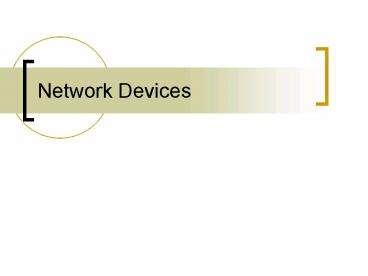Network Devices - PowerPoint PPT Presentation
1 / 46
Title:
Network Devices
Description:
Title: Network Device Author: jica Last modified by: dosen Created Date: 8/20/2003 2:51:22 AM Document presentation format: On-screen Show Company – PowerPoint PPT presentation
Number of Views:177
Avg rating:3.0/5.0
Title: Network Devices
1
Network Devices
2
Network Devices
3
Media on PC
- Ethernet
- Modem
- PC Card (WLAN)
- DVB
4
Ethernet - Architecture
5
Ethernet IEEE 802.3
- 10Base5 Thick wire coaxial
- 10Base2 thin wire coaxial / cheaper net
- 10BaseT Twisted Pair
- 10BaseF Fiber Optics
- 100BaseT Fast Ethernet
6
Ethernet 10Base5
7
Ethernet 10Base2
8
Ethernet 10BaseT
9
NIC Connector type
- Coaxial Cable
- Bayonet Nut Connector (BNC)
- Twisted Pair Cable
- RJ-45 (8 wire)
- Fiber Optics
- SMA connectors
10
Modem
- Allows modems of different vendors to operate
together - Define How modems operate
- Modulation techniques
- Data compression technique
- Error detection strategy
11
Modem Analog vs Digital
- Analog
- Infinite number of levels
- Conform to voice pattern
- Times from highest to lowest and back to the
highest point in one second is the frequency - Can be transmitted over long distance
- Digital
- Only two levels (high and low)
- Conforms to how computers operate
- Cannot transmitted over long distance
12
Modem - Connection
13
Modem Internal/External
14
PC Card WLAN (802.11)
- Bypassing last mile
15
PC Card (WLAN) - 1
16
PC Card (WLAN) - 2
17
PC Card (WLAN) Indoor Antena
18
DVB DVB/IP Tech
- The Digital Video Broadcast over Internet
Protocol (DVB/IP) system is functionally an
IP-over-Ethernet simplex satellite service that
incorporates frame-relay type traffic management.
At its core, DVB is a modem-on-a-chip, plus an
intelligent multiplexer. The antenna is typically
a CATV dish, 2.4 - 3.8 meters in diameter (for
C-band), or 0.6 -1.8 meters (for Ku-band).
19
DVB DVB/IP Routing
20
DVB - Adaptability
21
DVB DVB Card
22
Media
- Wired
- Twisted Pair UTP
- Coaxial
- Fiber
- Wireless
- Microwave
- Satellite
23
Twisted Pair
- Two wired wrapped in a twisted fashion
- Designed to reduce cross-talk due inductance
- Still subject to interference from stray signal
- Primarily used for local loop connections and
LANs - Comparatively narrow bandwidth
24
UTP Unshielded Twisted Pair
- Pair 1
- White/blue
- Blue
- Pair 2
- White/Orange
- Orange
- Pair 3
- White/Green
- Green
- Pair 4
- White/Brown
- Brown
- RJ45 Connector
25
UTP Straight Cable
- Wo/O Wg/B Wb/G Wbr/Br
26
UTP Cross Cable
- Wg/G Wo/B Wb/O Wbr/Br
27
UTP - Category
Category Maximum Data Rate Usual Application
CAT 1 Less than 1 Mbps Analog voice (POTS),
Integrated Services Digital Network Basic Rate Interface in ISDN
Doorbell wiring
CAT 2 4 Mbps Mainly used in the IBM Cabling System for token ring networks
CAT 3 16 Mbps Voice and data on 10BASE-T Ethernet
CAT 4 20 Mbps Used in 16 Mbps Token Ring
Otherwise not used much
CAT 5 100 Mbps 100 Mbps TPDDI (100BASE-T or Fast Ethernet)
1000 Mbps (4 pair) 155 Mbps ATM
Gigabit Ethernet
CAT 5E 100 Mbps 100 Mbps TPDDI (100BASE-T or Fast Ethernet)
155 Mbps ATM
CAT 6 200-250 MHz Super-fast Broadband Applications.
28
Coaxial
- Center lead conducts the signal
- Protected by insulation and braded wire
- Used mostly for television and connections to
antenna - Larger Bandwidth but large in size
29
Fiber Optical
- Signal transmitted by photos rather than
electrons - Dramatically higher bandwidth
- Used mostly for backbone communication
connections, very high speed LANs and fast
network connections
30
Microwave Antenna (1)
- Omni
- 2.4GHz 8dBi
31
Microwave Antenna (2)
- Sectoral
- 14dBi 180deg
32
Microwave Antenna (3)
- Sectoral
- 17dBi 90deg
33
Microwave Antenna (4)
- Direct (Grid)
- 2.4 GHz 24dB
34
Microwave Power AMP
35
Satellite - Broadband
36
Media Comparison
37
Multiplexer
- HUB
- Switch
- Bridge
- Router
38
Hub versus Switch
- Hub provide connection to all ports (i.e. in one
port and out all other ports). - Passive hub no signal regeneration
- Active hub provide signal regeneration
- Switch direct the message from appropriate port
(directs a message from the input port to the
desired output port). - More expensive but better bandwidth utilization
39
Hub versus Switch
40
LAN Hub device
41
Hub
42
LAN Switch device
43
Switch
44
Bridge Access Point (WLAN)
45
Router
- Connecting different segment
- Have different interfaces (Ethernet, WAN-Serial,
Fiber, etc) - Table Routing
46
Router

